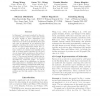Free Online Productivity Tools
i2Speak
i2Symbol
i2OCR
iTex2Img
iWeb2Print
iWeb2Shot
i2Type
iPdf2Split
iPdf2Merge
i2Bopomofo
i2Arabic
i2Style
i2Image
i2PDF
iLatex2Rtf
Sci2ools
KDD
1997
ACM
1997
ACM
Automated Discovery of Active Motifs in Three Dimensional Molecules
In this paper 1 we present a method for discovering approximately common motifs (also known as active motifs) in three dimensional (3D) molecules. Each node in a molecule is represented by a 3D point in the Euclidean Space and each edge is represented by an undirected line segment connecting two nodes in the molecule. Motifs are rigid substructures which may occur in a molecule after allowing for an arbitrary number of rotations and translations as well as a small number (specified by the user) of node insert/delete operations in the motifs or the molecule. (We call this “approximate occurrence.”) The proposed method combines the geometric hashing technique and block detection algorithms for undirected graphs. To demonstrate the utility of our algorithms, we discuss their applications to classifying three families of molecules pertaining to antibacterial sulfa drugs, anti-anxiety agents (benzodiazepines) and antiadrenergic agents (β receptors). Experimental results indicate the ...
| Added | 08 Aug 2010 |
| Updated | 08 Aug 2010 |
| Type | Conference |
| Year | 1997 |
| Where | KDD |
| Authors | Xiong Wang, Jason Tsong-Li Wang, Dennis Shasha, Bruce A. Shapiro, Sitaram Dikshitulu, Isidore Rigoutsos, Kaizhong Zhang |
Comments (0)

